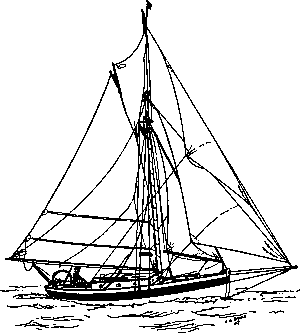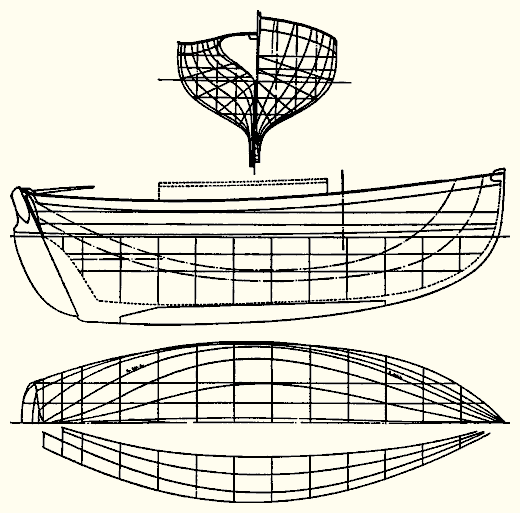
| Fore An' Aft A 28' 8" Cutter By William Atkin |

| |
| To modern eyes accustomed to long ends on a boat, the nearly plumb stem and short counter of Fore An' Aft may appear old-fashioned. But old-fashioned or not, I know of no better profile for a small cruising yacht. How else, I ask you, can any room be gotten below if the ends are pulled out and the forefoot cut away? Despite her modest overall length of 28 feet 8 inches, this little ship has a remarkable amount of room, not only below but on deck as well. And then in a short-ended boat like Fore An' Aft, accommodations can be nicely managed for a party of four, which is all that should ever be aboard a boat of this size. | |

| |
Fore An' Aft is 28 feet 8 inches in over all length, has a water line length of 27 feet, a breadth of 9 feet 6 inches, and a draft of 5 feet 2 1/2 inches. Her displacement, loaded for a cruise, is 19,200 lbs. Light displacement (2 in. above L.W.L.) is 16,900 lbs. There is a happy proportion between the iron on the keel and the ballast carried inside; the iron weighs 3,500 pounds and the lead inside, exactly the same. I think it is pretty well known that comfortable sea boats carry a good proportion of their ballast inside. In a cutter the mast should be stepped two-fifths the waterline length abaft the fore end of the load waterline. Thus it is in Fore An' Aft. The result is a small mainsail, short boom and a long bowsprit. Now a long bowsprit is a wet thing when it is rough; but why go out on it? There are two alternatives: one, the fitting of a Wykenam-Martin jib furler; the other, the fitting of a sliding ring to which the tack of the jib is shackled. Now this ring (shackled to the tack of the jib, of course) is hauled in or out the bowsprit with an outhaul. Can anything be simpler, especially in a small yacht like this? The jib is set flying if the ring is used, or left rolled up on the wire luff rope if the jib furler is used. The area of the cutter's sails are: main, 336 square feet; jib, 128 square feet; fore staysail, 84 square feet; topsail, 97 square feet. All the sails are cross-cut and, with her topsail, have a total area of 716 square feet. | |

| |
The deck plan is not at all like the yachts to which we are accustomed. The bowsprit is set on the starboard side of the stem head. A span shackle holds the spar against the side of the squared-off stem head, while the heel slips through between the bitts. The cranse iron on the end of the bowsprit is on the centerline of the ship; but the spar is splayed. The advantage of this arrangement is that the bowsprit can be reefed, hauled inboard. Several slots cut through the spar and fitted with a fid permit it to be reefed at varying lengths from the stem. You will bless a reefing bowsprit, and a reefing topmast, too, the day your cruising brings you in company with some mighty windstorm. In fact you will likely wish you had a reefing mast, or better still that you had remained ashore. Any yacht built for cruising should have a fairly high rail -- not a strip of inch-high moulding screwed along the edge of the covering board. Our little ship carries the rail cap 8 inches above the deck, and as the top timbers are spaced every 20 inches she looks, and is, a ship. The high rail permits the tiller to swing under the cap, simplifying the form of the traveller and contributing to the pleasing appearance of the stern. Then there are two berths in the main cabin, a galley, chart table, tool lockers, food lockers; and besides all these comforts the headroom under the cabin trunk is 5 feet 10 inches. The cabin is 6 feet 3 inches long and has built-in settees either side. These are 18 inches wide, made to sit on, not to sleep on. The sleeping bunks are made to fold against the face of the row of lockers under the decks. These folding bunks are boxes, made to fit the space above the settees, 6 feet 2 inches in length, 2 feet 2 inches in width, and fitted with thick V-spring mattresses. The lockers behind the bunks provide a convenient place for blankets, linen, and all that sort of gear. There are two clothes lockers abreast the mast, their doors opening against the butt of the mast, giving the desired privacy to the double bunks forward. Measure off 4 feet 3 inches on the wall; this is the headroom under the deck forward -- lots more than you think! And there is 5 feet of headroom under the forward hatch cover -- not so bad for so small a yacht. The bunks in the forecastle are 6 feet 2 inches long, 2 feet wide at their after ends and 18 inches wide forward. The water closet is tucked in under a cushioned seat between the feet of the bunks. The chain locker is under the forward ends of these bunks. | |

| |
| Turning to the lines, we find this Fore An' Aft had many of the characteristics of the wonderful double-enders developed by the late Colin Archer -- the sailing lifeboats of the North Sea -- but much fined out. She is sharp forward and aft on the waterline, and has enough bilge to assure stiffness, but not so much as to make a hard sailer. The center of lateral resistance and the center of buoyancy are nearly in the same fore-and-aft plane. When this little Fore An' Aft rolls down under the press of a stiff breeze these two elements remain in precisely the same position. That is why she sails so easily: the point of lateral resistance is not quarreling with the center of buoyancy. Another reason why she sails so well, especially when off the wind, is that the center of the sail plan is well forward of the common center of the lateral plane and the center of buoyancy. Above the waterline, Fore An' Aft is symmetrical; I tried to create a form in which the bow and stem will harmonize, and they do. The short ends produce a hull with a long waterline, and despite the generous breadth of 9 feet 6 inches the general appearance is one of slimness. The deck line aft over the counters is well-rounded which gets away from the boxlike angles where the sides meet the transom. While this rounding off of the deck line aft complicates the construction, I feel the rounding process is well worth while. | |

| |
| Now we come to the engine. The little two-cycle engine installed in Great Republic could not have given better service. To be sure, it was a two-cycle type, supposedly difficult to start. That little five-dollar engine always started and always ran. I have no quarrel with this type. But that is no reason why you should not install something else if you should build a cruising yacht like this. There is ample room for a small four-cylinder Universal or Redwing engine fitted with reverse gear, or a two-cylinder, four-cycle like the 8-10 horsepower Kermath. | |
 PHOTOS OF FORE AN' AFT PHOTOS OF FORE AN' AFT 
| |
| Plans for Fore An' Aft are $250 MYSTIC SEAPORT MUSEUM SHIPS PLANS STORE https://store.mysticseaport.org/ships-plans/ shipsplanstore@mysticseaport.org
+1 (860) 572 5360 | |
| BACK TO PLAN LIST | |